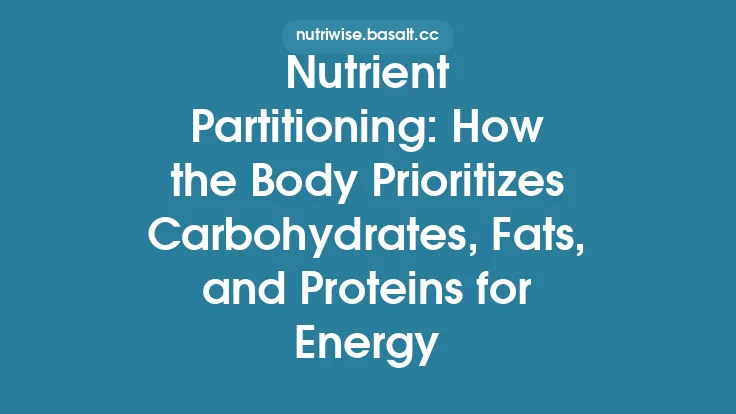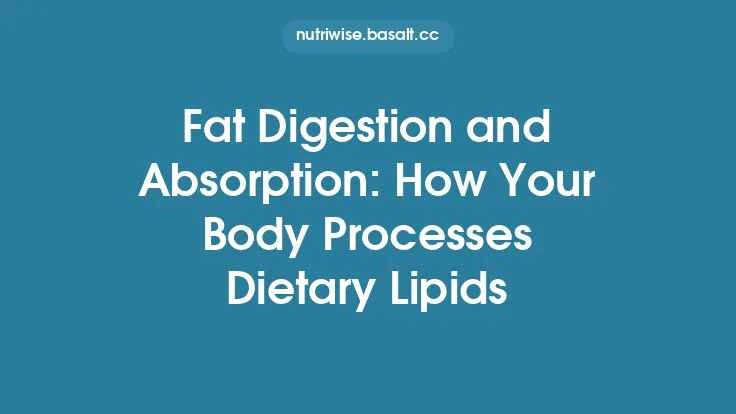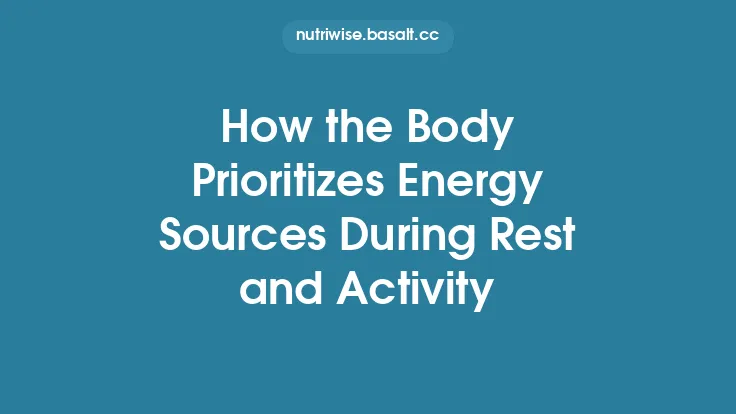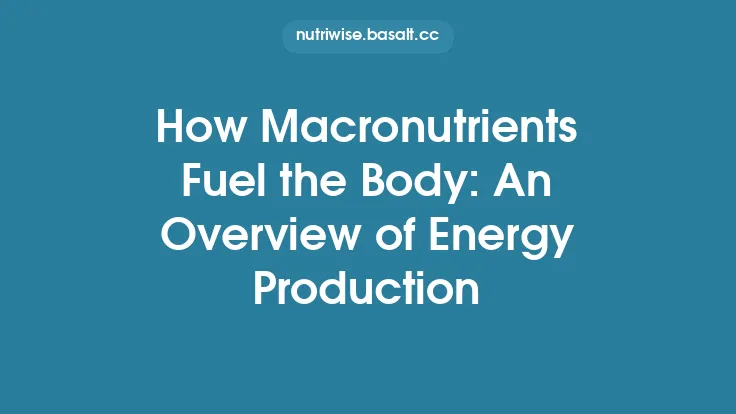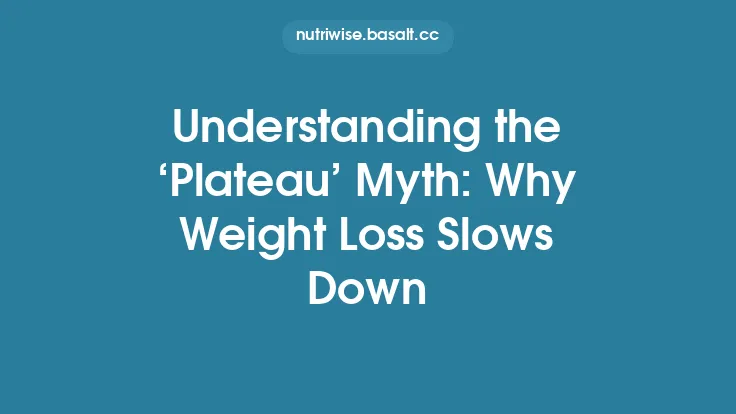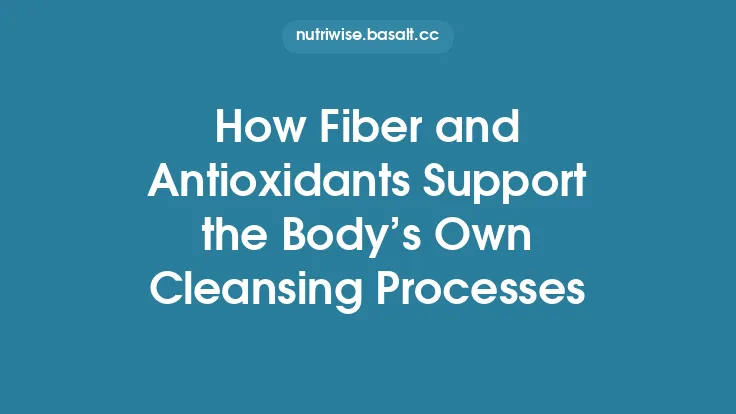The body’s ability to toggle between breaking down fat for immediate energy and storing excess energy as new fat is a cornerstone of metabolic homeostasis. While carbohydrates and proteins receive much of the popular attention, the pathways that govern fatty‑acid catabolism (β‑oxidation) and fatty‑acid synthesis (lipogenesis) are equally intricate and essential. This article walks through each step, from the moment dietary lipids enter the bloodstream to the point where they are either oxidized in the mitochondria or re‑assembled into triglycerides for long‑term storage. By understanding the enzymes, cofactors, and cellular compartments involved, we gain insight into how the body maintains energy balance, adapts to nutritional states, and what goes awry in metabolic disease.
Dietary Fat Digestion and Absorption
- Emulsification – Bile salts, secreted by the liver and stored in the gallbladder, coat large lipid droplets, increasing surface area and making them accessible to pancreatic lipase.
- Hydrolysis – Pancreatic lipase, aided by colipase, cleaves triglycerides into two free fatty acids (FFAs) and one 2‑monoacylglycerol (2‑MAG).
- Micelle Formation – The products, together with bile salts, form mixed micelles that ferry lipids across the unstirred water layer of the intestinal brush border.
- Enterocyte Uptake – FFAs and 2‑MAG diffuse or are transported into enterocytes via fatty‑acid transport proteins (e.g., CD36, FATP). Inside the cell, they are re‑esterified to triglycerides in the endoplasmic reticulum (ER).
- Chylomicron Assembly – Triglycerides are packaged with cholesterol, phospholipids, and apolipoprotein B‑48 into chylomicrons, which are secreted into the lymphatic system and eventually enter the bloodstream.
Cellular Uptake and Intracellular Trafficking of Fatty Acids
- Plasma Transport – Circulating FFAs bind to albumin; chylomicron‑derived triglycerides are hydrolyzed by lipoprotein lipase (LPL) on capillary endothelium, releasing FFAs locally.
- Membrane Transport – FFAs cross the plasma membrane by passive diffusion (especially short‑ and medium‑chain) or via facilitated transporters (CD36, FATP, FABPpm).
- Cytosolic Binding Proteins – Once inside, fatty‑acid‑binding proteins (FABPs) shield the hydrophobic chain, direct it to metabolic fates, and prevent detergent‑like damage to membranes.
- Activation – Before oxidation or synthesis, each fatty acid is “activated” to fatty‑acyl‑CoA by acyl‑CoA synthetase (ACS) in an ATP‑dependent reaction:
\[
\text{FA} + \text{CoA} + \text{ATP} \rightarrow \text{FA‑CoA} + \text{AMP} + \text{PP_i}
\]
Mitochondrial β‑Oxidation: The Stepwise Catabolism of Fatty Acids
β‑Oxidation occurs primarily in the mitochondrial matrix (with a complementary peroxisomal pathway for very‑long‑chain fatty acids). The process removes two‑carbon acetyl units from the acyl‑CoA chain in a cyclic series of four reactions:
- Acyl‑CoA Dehydrogenation – Acyl‑CoA dehydrogenase (ACAD) introduces a trans‑Δ² double bond, producing trans‑Δ²‑enoyl‑CoA and reducing FAD to FADH₂. Different ACAD isoforms (short‑, medium‑, long‑, very‑long‑chain) confer chain‑length specificity.
- Hydration – Enoyl‑CoA hydratase adds water across the double bond, yielding L‑3‑hydroxyacyl‑CoA.
- Dehydrogenation – 3‑Hydroxyacyl‑CoA dehydrogenase oxidizes the hydroxyl group to a keto group, generating NADH.
- Thiolysis – β‑Ketothiolase cleaves the β‑ketoacyl‑CoA, releasing acetyl‑CoA and a shortened acyl‑CoA (by two carbons), ready for another round.
Each round yields:
- 1 FADH₂ (≈1.5 ATP equivalents)
- 1 NADH (≈2.5 ATP equivalents)
- 1 acetyl‑CoA (≈10 ATP equivalents when fully oxidized in the TCA cycle)
The total ATP yield depends on the fatty‑acid chain length; for a 16‑carbon palmitate, complete oxidation produces roughly 106 ATP molecules.
Carnitine Shuttle – Gating Access to the Mitochondrial Matrix
Long‑chain acyl‑CoAs cannot cross the inner mitochondrial membrane directly. The carnitine shuttle mediates their entry:
- CPT I (carnitine palmitoyl‑transferase I) on the outer membrane transfers the acyl group from CoA to carnitine, forming acyl‑carnitine.
- CACT (carnitine‑acylcarnitine translocase) exchanges acyl‑carnitine into the matrix for free carnitine moving out.
- CPT II on the inner membrane reconverts acyl‑carnitine back to acyl‑CoA, releasing free carnitine to be recycled.
Malonyl‑CoA, the first committed intermediate of lipogenesis, allosterically inhibits CPT I, providing a rapid “switch” that prevents simultaneous synthesis and degradation of fatty acids.
Regulation of β‑Oxidation
- Allosteric Control – High malonyl‑CoA (fed state) suppresses CPT I; low malonyl‑CoA (fasted state) relieves inhibition.
- Transcriptional Regulation – Peroxisome proliferator‑activated receptor α (PPARα) up‑regulates genes encoding ACADs, CPT I, and other β‑oxidation enzymes during prolonged fasting or high‑fat diets.
- Energy Charge – Elevated NAD⁺/NADH and ADP/ATP ratios stimulate dehydrogenases, enhancing flux through the pathway.
- Hormonal Signals – While a deep hormonal discussion is beyond this scope, catecholamine‑driven lipolysis increases plasma FFAs, indirectly feeding β‑oxidation.
Lipogenesis: Constructing New Fatty Acids
When energy intake exceeds immediate demand, excess acetyl‑CoA (derived mainly from carbohydrate metabolism) is diverted to fatty‑acid synthesis in the cytosol. Lipogenesis proceeds through a series of well‑coordinated steps:
- Citrate Export – Mitochondrial acetyl‑CoA condenses with oxaloacetate to form citrate, which is shuttled out of the mitochondria via the citrate transporter.
- Cytosolic Acetyl‑CoA Generation – ATP‑citrate lyase (ACL) cleaves citrate back into acetyl‑CoA and oxaloacetate, consuming ATP.
- Malonyl‑CoA Formation – Acetyl‑CoA carboxylase (ACC) carboxylates acetyl‑CoA to malonyl‑CoA, the committed step of lipogenesis. ACC activity is regulated by phosphorylation (AMP‑activated protein kinase, AMPK, phosphorylates and inactivates ACC) and allosteric effectors (citrate activates, long‑chain acyl‑CoAs inhibit).
- Fatty‑Acid Synthase (FAS) Cycle – A multifunctional enzyme complex (FAS) iteratively elongates the growing fatty‑acid chain:
- Condensation – Malonyl‑CoA (donor) condenses with the primer acetyl‑CoA, releasing CO₂.
- Reduction – The β‑keto group is reduced to a β‑hydroxy group using NADPH.
- Dehydration – Water is removed, forming a trans‑Δ² double bond.
- Second Reduction – The double bond is reduced to a saturated chain using another NADPH molecule.
- The cycle repeats, adding two carbons per turn, until a 16‑carbon palmitate is released.
- Elongation & Desaturation – Palmitate can be further elongated by elongases (adding two‑carbon units) and desaturated by stearoyl‑CoA desaturase (SCD) to generate a variety of fatty acids required for membrane phospholipids and signaling molecules.
NADPH Supply for Lipogenesis
NADPH is the reducing power needed for the two reduction steps in each FAS cycle. The primary cytosolic sources are:
- Malic Enzyme (ME) – Converts malate to pyruvate, producing NADPH.
- Cytosolic Isocitrate Dehydrogenase (IDH1) – Oxidizes isocitrate to α‑ketoglutarate, generating NADPH.
- Pentose Phosphate Pathway (PPP) – Although the PPP is a major NADPH source, its detailed mechanics are covered elsewhere; it nonetheless contributes to the NADPH pool available for lipogenesis.
Compartmentalization: Why Location Matters
- Mitochondria – Site of β‑oxidation; the high‑energy environment (high NAD⁺/FAD) drives efficient oxidation.
- Peroxisomes – Handle very‑long‑chain fatty acids (>22 C) and branched‑chain fatty acids, shortening them to lengths amenable to mitochondrial β‑oxidation. The initial oxidation steps generate H₂O₂, which is detoxified by catalase.
- Cytosol/ER – Lipogenesis occurs here; the ER also hosts the enzymes that esterify newly formed fatty acids into triglycerides and phospholipids.
- Lipid Droplets – Serve as storage depots for neutral lipids (triglycerides, cholesteryl esters). Their surface proteins (e.g., perilipins) regulate access of lipases and thus the balance between storage and mobilization.
Reciprocal Regulation: The “Push‑Pull” Between Oxidation and Synthesis
The metabolic network is designed to avoid futile cycling:
- Malonyl‑CoA as a Bifunctional Signal – High levels stimulate lipogenesis (substrate for FAS) and simultaneously inhibit CPT I, preventing entry of fatty acids into the mitochondria.
- Acetyl‑CoA Partitioning – When energy is abundant, acetyl‑CoA is preferentially directed toward ACL and ACC; during energy deficit, acetyl‑CoA is channeled into the TCA cycle and β‑oxidation.
- Transcriptional Crosstalk – PPARα activation (fasted) up‑regulates β‑oxidation genes while down‑regulating lipogenic genes; conversely, sterol regulatory element‑binding protein‑1c (SREBP‑1c) promotes lipogenic gene expression in the fed state.
Physiological Contexts
| Nutritional State | Dominant Pathway | Key Metabolic Signals |
|---|---|---|
| Fasting / Exercise | β‑Oxidation ↑, Lipogenesis ↓ | Low insulin, high glucagon, ↑cAMP, ↓malonyl‑CoA |
| Post‑prandial (Carbohydrate‑rich) | Lipogenesis ↑, β‑Oxidation ↓ | High insulin, ↑glucose, ↑citrate, ↑malonyl‑CoA |
| High‑fat, Low‑carb (Ketogenic) | Sustained β‑oxidation, hepatic ketogenesis | Low insulin, high FFAs, ↑acetyl‑CoA |
| Overnutrition / Obesity | Simultaneous high β‑oxidation and lipogenesis (inefficient regulation) | Hyperinsulinemia, chronic elevation of both FFAs and malonyl‑CoA |
Clinical Relevance
- Inherited Fatty‑Acid Oxidation Disorders – Deficiencies in ACADs, CPT I/II, or CACT lead to hypoketotic hypoglycemia, cardiomyopathy, and muscle weakness, especially during fasting.
- Non‑Alcoholic Fatty Liver Disease (NAFLD) – Excessive lipogenesis (driven by chronic hyperinsulinemia and high carbohydrate intake) overwhelms hepatic export capacity, causing triglyceride accumulation.
- Obesity & Metabolic Syndrome – Dysregulated malonyl‑CoA signaling and impaired AMPK activation blunt the inhibition of CPT I, contributing to ectopic fat deposition.
- Pharmacologic Targets – ACC inhibitors (e.g., firsocostat) and CPT I activators are under investigation to modulate hepatic fat synthesis and oxidation, respectively.
Summary
Beta‑oxidation and lipogenesis represent two sides of the same metabolic coin: one dismantles fatty acids to harvest energy, the other assembles them for storage. Their coordination hinges on a handful of pivotal metabolites—acetyl‑CoA, malonyl‑CoA, citrate, and NADPH—and on compartment‑specific enzyme complexes that respond to the body’s energetic state. By mastering the flow of fatty acids through these pathways, we gain a clearer picture of how diet, activity, and cellular signaling converge to maintain energy balance, and why disruptions can precipitate disease. Understanding these evergreen mechanisms equips researchers, clinicians, and nutrition professionals with the foundation needed to develop strategies that promote metabolic health.
